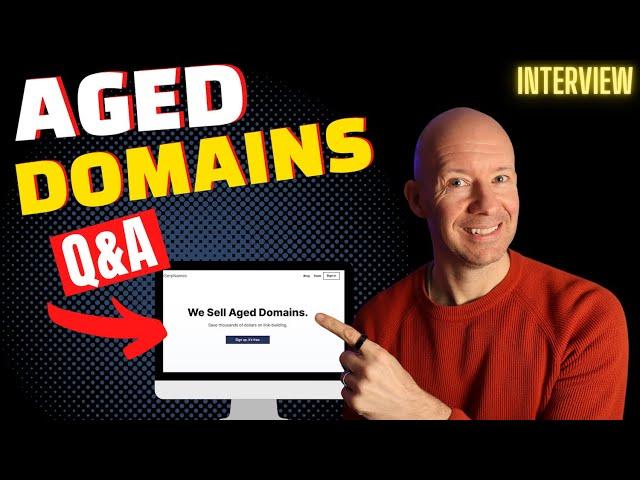Table of Contents
- Understanding the Value of Aged Domains for SEO Success
- Key Factors to Consider When Selecting an Aged Domain
- Effective Strategies to Research and Evaluate Aged Domains
- Best Practices for Transitioning to an Aged Domain
- Common Myths and Misconceptions About Aged Domains
- Q&A
- Insights and Conclusions
Understanding the Value of Aged Domains for SEO Success
Aged domains offer a plethora of advantages that can accelerate your SEO efforts. One of the primary benefits is the authority they often possess. These domains have been around for a while, allowing them to accumulate backlinks from various sources over time. This longevity can translate into better rankings on search engine results pages (SERPs). Additionally, established domains are less likely to engage in practices that could lead to penalties, making them a safer investment for your online presence.
Another crucial factor to consider is the traffic potential of aged domains. Many come with existing organic traffic, which can give your site an immediate boost. This traffic can be leveraged into conversions or as a foundation for growing your audience further. When searching for aged domains, it’s vital to check metrics such as:
- Domain Authority (DA)
- Page Authority (PA)
- Backlink Quality
Ultimately, the key to unlocking the full potential of an aged domain lies in a strategic approach to content development and SEO practices. Here’s a simple comparison of new vs. aged domains:
| Feature | Aged Domains | New Domains |
|---|---|---|
| Backlink Profile | Established, often high-quality | Typically minimal or nonexistent |
| Rank Potential | Higher from the start | Needs time to build |
| Traffic Flow | Possible existing traffic | Usually requires SEO efforts |


Key Factors to Consider When Selecting an Aged Domain
When selecting an aged domain, it’s crucial to evaluate its history and reputation. A domain with a positive past can offer instant credibility and SEO benefits, while a negative history could hinder your efforts. Utilize tools like SEMrush or Ahrefs to check the domain’s backlink profile, ensuring it has quality links from reputable sites. Pay attention to domain authority scores, as higher scores indicate a strong SEO standing. You should also examine the domain’s previous ownership and usage to ascertain its credibility. Next, consider the domain’s keyword relevance. An aged domain should ideally include keywords that align with your target market. This not only helps in optimizing for search engines but also enhances user experience by providing a sense of trust and relatability. Conduct thorough keyword research to identify domains that effectively incorporate these terms. Here’s a quick checklist for assessing keyword relevance:- Inclusion of primary keywords
- Length of the domain name
- Avoidance of hyphens or numbers
| Factor | Importance | Notes |
|---|---|---|
| Domain Age | High | Older domains are often seen as more trustworthy. |
| Backlink Profile | Very High | Quality links boost SEO value significantly. |
| Previous Use | Medium | Avoid domains with spam or adult content history. |


Effective Strategies to Research and Evaluate Aged Domains
When embarking on the journey of acquiring aged domains, thorough research is crucial. Begin by assessing the domain’s backlink profile. Use tools like Ahrefs or Moz to dive into the links pointing to the domain. Look for high-authority links and organic traffic metrics, as these can indicate the domain’s previous SEO value. Consider the following factors:
- Domain Authority (DA): A higher score generally signifies a more valuable domain.
- Link Quality: Focus on the relevance and authority of the websites linking back.
- Natural vs. Artificial Links: Determine if the backlinks were obtained through legitimate means or manipulative practices.
Another vital aspect is the domain’s history and usage. Utilize tools such as the Wayback Machine to explore how the domain was previously used. Check for any previous associations with illicit activities or spammy content. Create a checklist of elements to verify:
- Past Website Content: Was it consistent with the niche you’re targeting?
- Change in Ownership: Frequent changes might suggest instability.
- Domain Age: The older, the better, provided it has a clean slate.
always evaluate the domain’s potential for future branding and SEO advantages. Does the domain name have the potential for memorable branding? Use keyword research to ensure it aligns with the desired niche. Assess it against competitors using the following comparative table:
| Aspect | Your Domain | Top Competitor |
|---|---|---|
| DA | 25 | 35 |
| Number of Backlinks | 50 | 150 |
| Relevance Score | High | Medium |
By following these thorough strategies—evaluating the backlink profile, researching past usage, and comparing potential advantages—you can make a smart purchase that significantly boosts your online presence.


Best Practices for Transitioning to an Aged Domain
When transitioning to an aged domain, it’s essential to approach the process strategically to maximize its benefits. Start by conducting a thorough audit of the domain’s history. This includes checking for any previous penalties, problematic backlinks, and the overall reputation of the domain. Use tools like Google Search Console and various SEO analysis platforms to gain insights. A clean slate can significantly enhance your chances of a smooth transition and improved search engine visibility.
Next, implement a redirect strategy that maintains the domain’s existing authority while transitioning your content. This can be achieved through 301 redirects from old pages to new ones. Be sure to keep the URLs closely aligned in topic and content to ensure a seamless user experience. Additionally, update your internal links to point to the new domain, retaining link equity and allowing visitors to navigate your website easily. Here are some key steps to follow:
- Choose relevant content from the old domain.
- Maintain the same site structure wherever possible.
- Monitor traffic and engagement metrics post-migration.
enhance your new domain’s profile by actively engaging in link-building and content marketing strategies. Reach out to existing backlinks and request updates to point to your new domain. Develop high-quality, original content that resonates with your audience, helping to establish authority and drive traffic. By focusing on quality backlinks, social media engagement, and consistent updates, you can ensure your aged domain not only retains its strong foundation but also grows in value.


Common Myths and Misconceptions About Aged Domains
Aged domains often come with a cloud of myths that can mislead potential buyers. One significant misconception is that simply purchasing an aged domain guarantees immediate high rankings in search engine results. While these domains often have existing authority and backlinks, success in SEO relies on the overall quality of content and ongoing optimization efforts. Without a robust strategy for creating valuable content, the benefits associated with an aged domain may not materialize as expected.
Another prevalent belief is that all aged domains are inherently valuable just because of their age. However, it’s essential to consider the domain’s history and reputation. Domains that have been associated with spammy practices or have a history of low-quality content can be a liability rather than an asset. Here are a few factors to assess before making a purchase:
- Backlink Profile: Analyze the quality and relevance of backlinks pointing to the domain.
- Previous Usage: Investigate how the domain was previously used to identify any potential red flags.
- SEO Metrics: Review metrics like Domain Authority and Trust Flow to gauge the site’s credibility.
Some buyers fall prey to the illusion that the more aged a domain is, the better it will perform. While age can indeed contribute to a domain’s credibility, relevance and niche adaptability are just as important, if not more so. An aged domain that fits well within your industry can enhance your brand’s visibility and engagement rates, contrasting with one that doesn’t resonate with your target audience. Here’s a simple table highlighting essential considerations:
| Factor | Importance |
|---|---|
| Backlink Quality | High |
| Domain History | High |
| Niche Relevance | Critical |
| SEO Metrics | Essential |
Q&A
Q&A: Buying Aged Domains
Q1: What is an aged domain and why should I consider buying one? A: An aged domain is a website domain that has been registered for a significant period, often a few years or more. These domains carry value due to their history, which can include backlinks, existing traffic, and search engine authority. Purchasing an aged domain can give your new website a head start in SEO, potentially saving time and effort compared to starting with a brand new domain.Q2: How can I find quality aged domains for sale? A: There are several strategies to locate quality aged domains. Start by checking reputable domain auction sites like GoDaddy Auctions or Sedo. Additionally, domain broker services can help you find premium aged domains that aren’t listed publicly. Look for domains that have a clean history, meaning they haven’t been penalized by search engines and have maintained a relevant backlink profile.
Q3: What factors should I consider when evaluating an aged domain? A: When assessing an aged domain, consider several key factors:
- Domain Authority (DA): A higher DA often correlates with better search engine visibility.
- Backlink Profile: Analyze the quality and relevance of backlinks. Tools like Ahrefs or Moz can help.
- Past Usage: Research how the domain was previously used. If it had spammy content, it might carry some risk.
- Traffic Levels: Check if the domain has been receiving organic traffic. Analyzing historical traffic trends can be beneficial.
- Brand Potential: Ensure the domain name is relevant and memorable for your target audience.
Q4: Are there any risks associated with buying aged domains? A: Yes, there are potential risks to keep in mind. If the domain has a negative history, such as penalties from search engines or associations with fraudulent activity, it could harm your online reputation and rankings. Always conduct thorough due diligence, including a history check through tools like the Wayback Machine to see past content and using SEO analysis tools for a backlink audit.
Q5: How much should I expect to pay for an aged domain? A: The price of aged domains can vary widely based on several factors, including their domain authority, age, keyword relevance, and market demand. Basic domains might be available for a few hundred dollars, while premium domains can range from thousands to tens of thousands. It’s essential to assess the value based on your specific needs and the domain’s potential return on investment.
Q6: Can I redirect an aged domain to my new website? A: Yes, one common strategy when acquiring an aged domain is to redirect it to your new website. This can help transfer some of the existing traffic and authority from the aged domain to your primary site. However, it’s best to ensure that the content and audience of the aged domain align with your new website to avoid confusing visitors or hurting SEO efforts.
Q7: Should I focus on .com domains, or are other extensions acceptable? A: While .com domains are often preferred due to their popularity and credibility, other extensions like .net, .org, or even niche-specific extensions can still hold significant value. The key is relevance and potential; choose a domain that makes sense for your brand and resonates with your audience, regardless of the extension.
Q8: What’s the best strategy for making the most of an aged domain? A: To maximize the potential of an aged domain, integrate it thoughtfully into your overall SEO and content strategy. Create informative, high-quality content that resonates with your audience and enhances the existing authority of the domain. Also, actively work on improving the backlink profile by securing new, relevant links and optimizing for keywords. Patience and consistent effort can lead to substantial long-term benefits.
This Q&A guide should serve as a valuable resource, helping you navigate the intriguing market of aged domains with clarity and confidence.

